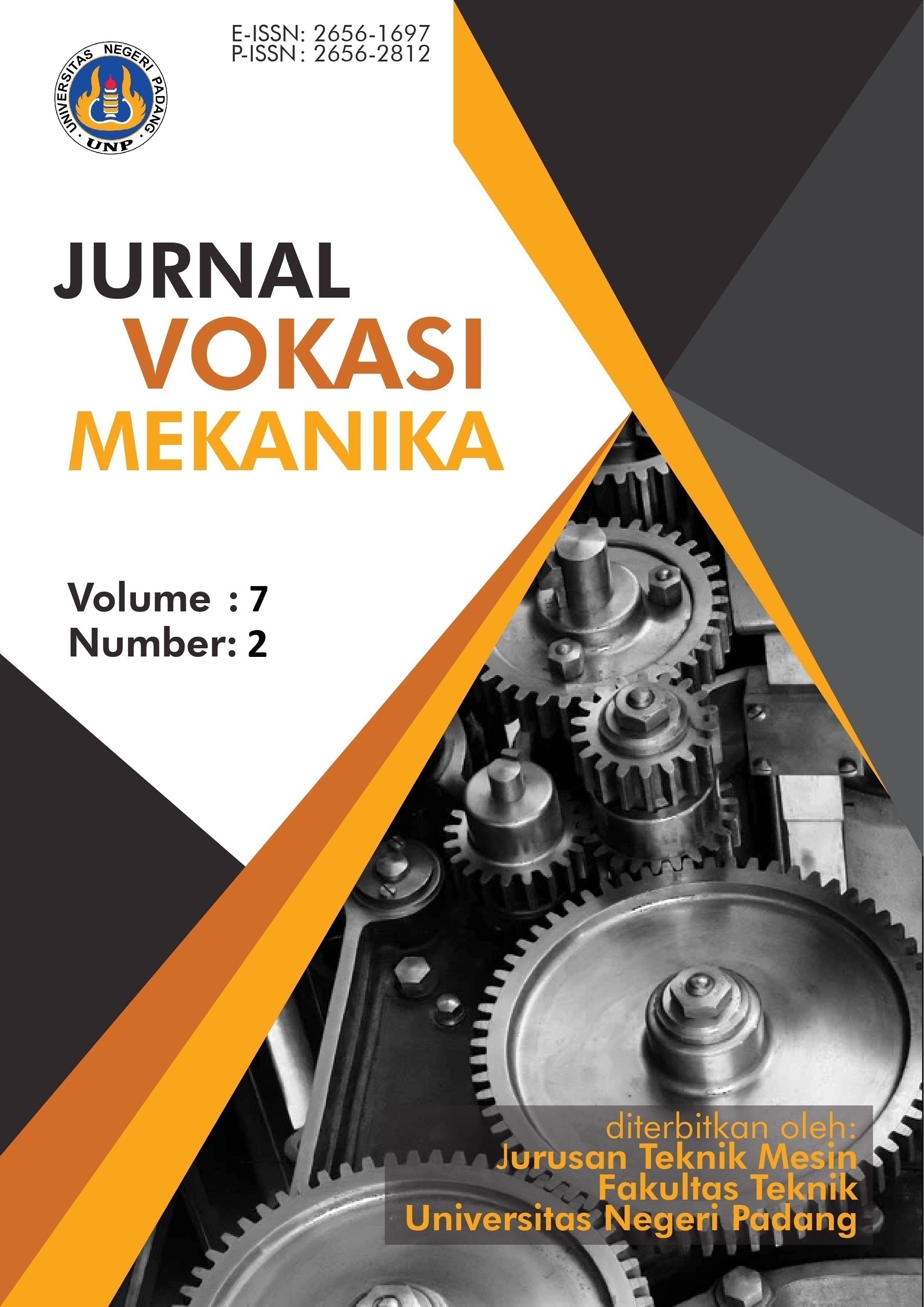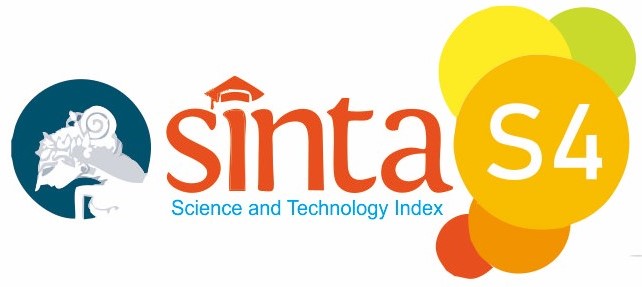The Effect of Workplace Health and Safety on Eleventh Grade Student Learning Outcomes in the Lathe Machining Engineering Subject at State Vocational School 1 Lembah Melintang
Abstract
The adoption of occupational safety and health (OHS) in vocational education environments, especially Vocational High Schools (SMK), is a crucial element in supporting a safe and effective practical learning process. However, observations at SMKN 1 Lembah Melintang showed that the implementation of OHS principles was not optimal, including the absence of consistency in utilizing personal protective equipment (PPE) and the unavailability of structured practice SOPs. Based on these conditions, this research endeavors to explore the effect of implementing OHS measures on students’ educational outcomess in the Lathe Machining Engineering subject for grade 11. the research applies a quantitative methodology with an associative analysis technique. The study population was all 31 students of grade 11 Machining Engineering, who were also sampled through total sampling techniques. Data acquisition was performed via questionnaires and documentation, then analyzed employing validity, reliability, normality, linearity, simple linear regression, and t-test analyses with SPSS. The outcome of the study showed that a significant positive correlation between the implementation of OHS and student learning outcome. The computed correlation coefficient indicated 0.708 and the determination value (R²) of 0.501 indicate that K3 contributes 50.1% to the variation of learning outcomes. The t-test shows a t-value of 5.395 > t-table 1.699 which strengthens the significance of the influence. Thus, it can be concluded that K3 has a key element in supporting improvements in student performance in learning the practice of lathe machining techniques
References
Adzim, H. I. (2013). Pengertian (Definisi) K3 (Keselamatan dan Kesehatan Kerja).
Alam, S., Anwar, B., & Adam, A. (2020). Pengaruh Perilaku Kesehatan dan Keselamatan Kerja (K3) di Bengkel terhadap Hasil Belajar Praktik Pemesinan Siswa Kelas XI SMK Negeri 10 Makassar. Universitas Negeri Makassar.
Alam, S., Anwar, B., & Adam, H. A. (2020). Pengaruh Perilaku Kesehatan Dan Keselamatan Kerja (K3) Di Bengkel Terhadap Hasil Belajar Praktik Pemesinan Siswa Kelas Xi Smk Negeri 10 Makassar. Eprints Universitas Negeri Makassar, 1–14.
Anizar. (2012). Teknik Keselamatan dan Kesehatan Kerja di Industri. Graha Ilmu.
Arrafi, M., Erizon, N., Arwizet, A., & Primawati, P. (2022). Kontribusi Pengetahuan Kesehatan dan Keselamatan Kerja (K3) dan Sikap Kerja terhadap Hasil Belajar Mata Pelajaran Produk dan Kreatif Kewirausahaan Siswa Kelas XI Teknik Permesinan di SMK Negeri 1 Padang. Jurnal Vokasi Mekanika, 4(4), 136–141.
Fridayanti, N., & Kusumasmoro, R. (2016). Penerapan Keselamatan dan Kesehatan Kerja di PT Ferron Par Pharmaceuticals Bekasi. Jurnal Administrasi Kantor.
Indonesia, K. K. R. (2021). K3 Tingkatkan Produktivitas Kerja pada Kegiatan Apel Mahasiswa K3 Seluruh Indonesia.
Indonesia, P. R. (2012). Peraturan Presiden Republik Indonesia Nomor 8 Tahun 2012 tentang Kerangka Kualifikasi Nasional Indonesia.
Irzal, M. K. (2016). Buku Dasar – Dasar Kesehatan & Keselamatan Kerja. In Kesehatan Masyarakat.
Kemenaker. (2016). Peraturan Menteri Tenaga Kerja Nomor 36 Tahun 2016 tentang Penyelenggaraan Pemagangan di Dalam Negeri.
Kemendikbud. (1997). Keputusan Menteri Pendidikan dan Kebudayaan Nomor 323/U/1997 tentang Penyelenggaraan Pendidikan Sistem Ganda pada Sekolah Menengah Kejuruan.
Kemendikbud. (2003). Undang-Undang Republik Indonesia Nomor 20 Tahun 2003 tentang Sistem Pendidikan Nasional.
Khodijah, N. (2014). Psikologi Pendidikan. Rajagrafindo Persada.
Kristina, N. (2014). Peranan Pengetahuan tentang Dunia Kerja terhadap Kesiapan Kerja Siswa Jurusan Teknik Pengolahan Hasil Pertanian (TPHP) Di SMK N 1 Pandak. Universitas Negeri Yogyakarta.
Kusuma, H. (2018). Pengangguran RI 6,87 Juta Orang, Paling Banyak Lulusan SMK.
Mustaqim. (2001). Psikologi Pendidikan. Pustaka Pelajar.
Nasehudin, T. S., & Gozali, N. (2012). Metode Penelitian Kuantitatif. Pustaka Setia.
Purwanto. (2007). Metodologi Penelitian Kuantitatif untuk Psikologi dan Pendidikan. Pustaka Pelajar.
Soputan, G., Sompie, B., & Mandagi, R. (2014). Manajemen Risiko Kesehatan Dan Keselamatan Kerja (K3) (Study Kasus Pada Pembangunan Gedung Sma Eben Haezar). Jurnal Ilmiah Media Engineering.
Sudarminta, J. (2002). Epistemologi Dasar: Pengantar Filsafat Pengetahuan. Kanisius.
Sugihartono, & others. (2013). Psikologi Pendidikan (2nd ed.). UNY Press.
Sugiyono. (2016). Metode Penelitian: Kuantitatif, Kualitatif, dan R&D. Alfabeta.
Sukmadinata, N. S. (2005). Metode Penelitian Pendidikan. Remaja Rosdakarya.
Surajiyo. (2007). Filsafat Ilmu dan Perkembangnanya di Indonesia. Bumi Aksara.
Suriasumantri, J. (1982). Filsafat Ilmu: Sebuah Pengantar Populer. Sinar Harapan.
Syah, M. (2010). Psikologi Pendidikan: Dengan Pendekatan Baru (rev). Remaja Rosdakarya.
Tawardjono. (2016). Faktor-Faktor Penyebab Rendahnya Motivasi Belajar dan Solusi Penanganan pada Siswa Kelas XI Jurusan Teknik Sepeda Motor. Jurnal Pendidikan Teknik Otomotif, 13(2).
Uno, H. B. (2006). Teori Motivasi & Pengukurannya: Analisis di Bidang Pendidikan. Bumi Aksara.
Usman, H., & Akbar, P. S. (2006). Pengantar Statistika (2nd ed.). Bumi Aksara.
Wagiran. (2007). Inovasi Pembelajaran dalam Penyiapan Tenaga Kerja Masa Depan. Jurnal Pendidikan lTeknologi Dan Kejuruan, 16(1).
Waluyo. (2018). Pentingnya Peran SMK di Era Revolusi Industri.
Widoyoko, S. E. P. (2012). Teknik Penyusunan Instrumen Penelitian. Pustaka Pelajar.
Yuliani, M., Wahyuni, I., & Ekawati, E. (2021). Hubungan Antara Pengetahuan, Penerapan Prosedur Kerja, Punishment dan Stres Kerja Terhadap Safety Behavior Pada Pekerja Konstruksi di PT X. Jurnal Kesehatan Masyarakat, 9(1), 58–64. https://doi.org/10.14710/jkm.v9i1.28570
Submitted
Copyright (c) 2025 Jurnal Vokasi Mekanika (VoMek)

This work is licensed under a Creative Commons Attribution 4.0 International License.








.svg_.png)


